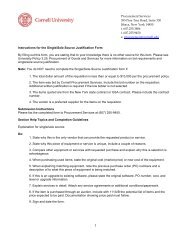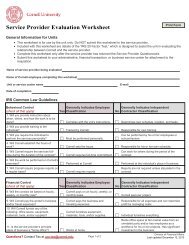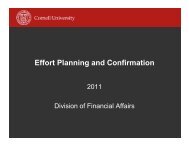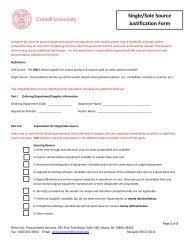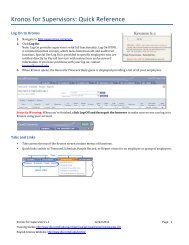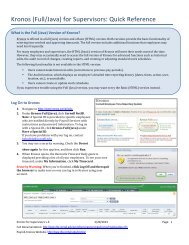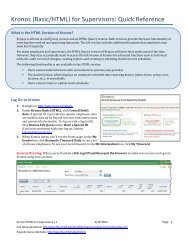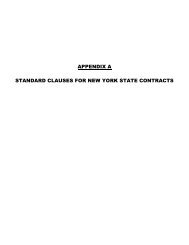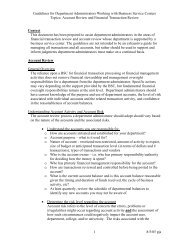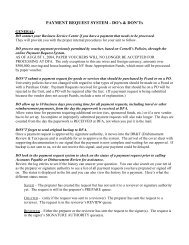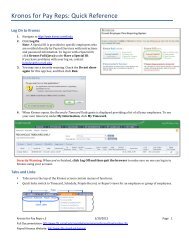Cornell University 2011-2012 Annual Report - DFA Home - Cornell ...
Cornell University 2011-2012 Annual Report - DFA Home - Cornell ...
Cornell University 2011-2012 Annual Report - DFA Home - Cornell ...
Create successful ePaper yourself
Turn your PDF publications into a flip-book with our unique Google optimized e-Paper software.
MESSAGE FROM THE VICE PRESIDENT FOR FINANCE ANDCHIEF FINANCIAL OFFICERAn exciting year indeed: the <strong>University</strong> brought fundraising to new, record-setting heights, won an international competitionto build “<strong>Cornell</strong> NYC Tech,” an applied sciences campus on Roosevelt Island in New York City, and balanced itsoperating budget for fiscal year 2013—one year ahead of schedule. These successes are a testament to <strong>Cornell</strong>’s generousalumni, its superb faculty, staff and students, and its exceptional position among leading institutions.In fiscal year <strong>2012</strong>, the <strong>University</strong> generated an operating surplus of almost $47 million. This was tempered, however,by lower market valuation on interest rate swaps and investment returns lower than operations payout, which madethe <strong>University</strong> show a modest loss in financial position—a $33 million decrease in net assets.There continues to be an extraordinary demand for a <strong>Cornell</strong> education. The <strong>University</strong> received a record-breakingnumber of applicants this past year. More than 37,808 prospective students applied for undergraduate admission. Thetotal enrollment in fall <strong>2012</strong> was 3,270, a strategic decrease from last year. <strong>Cornell</strong>’s geographical profile remains diverseand global, with nearly 10 percent of its undergraduate students coming from outside the United States, and 60 percentfrom states other than New York. <strong>Cornell</strong> continues to be very selective, with a mere 17 percent acceptance rate for fall<strong>2012</strong> freshman applicants, compared to 21 percent just five years prior. The matriculation yield rate has increased toan average of 52 percent, consistent with other highly competitive peers.The <strong>University</strong> renewed its commitment to a need-blind admission policy. Because of the fragile global economy,however, there was approximately a 10 percent increase in undergraduate student financial need over last year, and the<strong>University</strong> made modest adjustments to qualifying incomes in its financial aid program.<strong>Cornell</strong> remains a leader in research—this is significant because research programs attract outstanding faculty members,enhancing the educational experience for both undergraduate and graduate students. The <strong>University</strong> brought in over$600 million in grants and contracts focused primarily though not exclusively on basic research (including indirect costrecoveries) in fiscal year <strong>2012</strong>, which is over 19 percent of the <strong>University</strong>’s total operating revenues.Operating costs at <strong>Cornell</strong> are less dependent on endowment payout than other highly endowed institutions. Less than10 percent of the <strong>University</strong>’s operating costs were funded from its endowment in fiscal year <strong>2012</strong>, mostly due to itsrevenue diversity. The market value of <strong>Cornell</strong>’s investments is $5.9 billion as of June 30, <strong>2012</strong>.<strong>University</strong> revenues have tripled in the past 20 years. The largest growth area has been the Medical Physician Organization,which now makes up approximately 22 percent of the <strong>University</strong>’s total operating revenue (compared to 12 percentin fiscal year 1992). At the same time, state and federal appropriations have dropped from 12 percent of total revenuein fiscal year 1992 to approximately 5 percent today.<strong>Cornell</strong> has a history of strong fundraising, with an estimated 40 percent alumni participation rate or approximately88,000 contributing individuals. In fiscal year <strong>2012</strong>, the <strong>University</strong> received $611.2 million in contributions. As of fiscalyear-end <strong>2012</strong>, <strong>Cornell</strong> had approximately $1.9 million of bonds and notes outstanding, including $136 million ofoutstanding commercial paper and $500 million in taxable notes issued in 2009. Management expects to retire $250million of this taxable debt in 2014. The debt portfolio currently comprises 20 percent variable-rate and 80 percent fixedratedebt. The <strong>University</strong> has over $1 billion in interest rate swaps, whose fair value is determined by an external swapconsultant. Change in valuation between June 30, <strong>2011</strong> and June 30, <strong>2012</strong> created an additional $166 million liability.Because of the concentrated and committed actions we have taken over the last several years to address a weak economyand limited financial resources, we now see opportunities ahead of us. But our past successes are not a reason to relax—instead, we must stay on course. We must continue to reinforce our extraordinary competencies to focus on achievingour strategic plan, which includes the design of <strong>Cornell</strong> NYC Tech campus; we must also keep our financial systemflexible, so that it can adapt to changing issues and regulations.I am confident that our exciting plans in the years to come will ensure not only <strong>Cornell</strong>’s position as a preeminent researchuniversity with world-class faculty and staff, serving the most outstanding students without regard to financialstatus, but also <strong>Cornell</strong>’s strength in its commitment to academic integrity, intellectual progress, and fiscal vigor.2Joanne M. DeStefanoVice President for Finance and Chief Financial Officer



